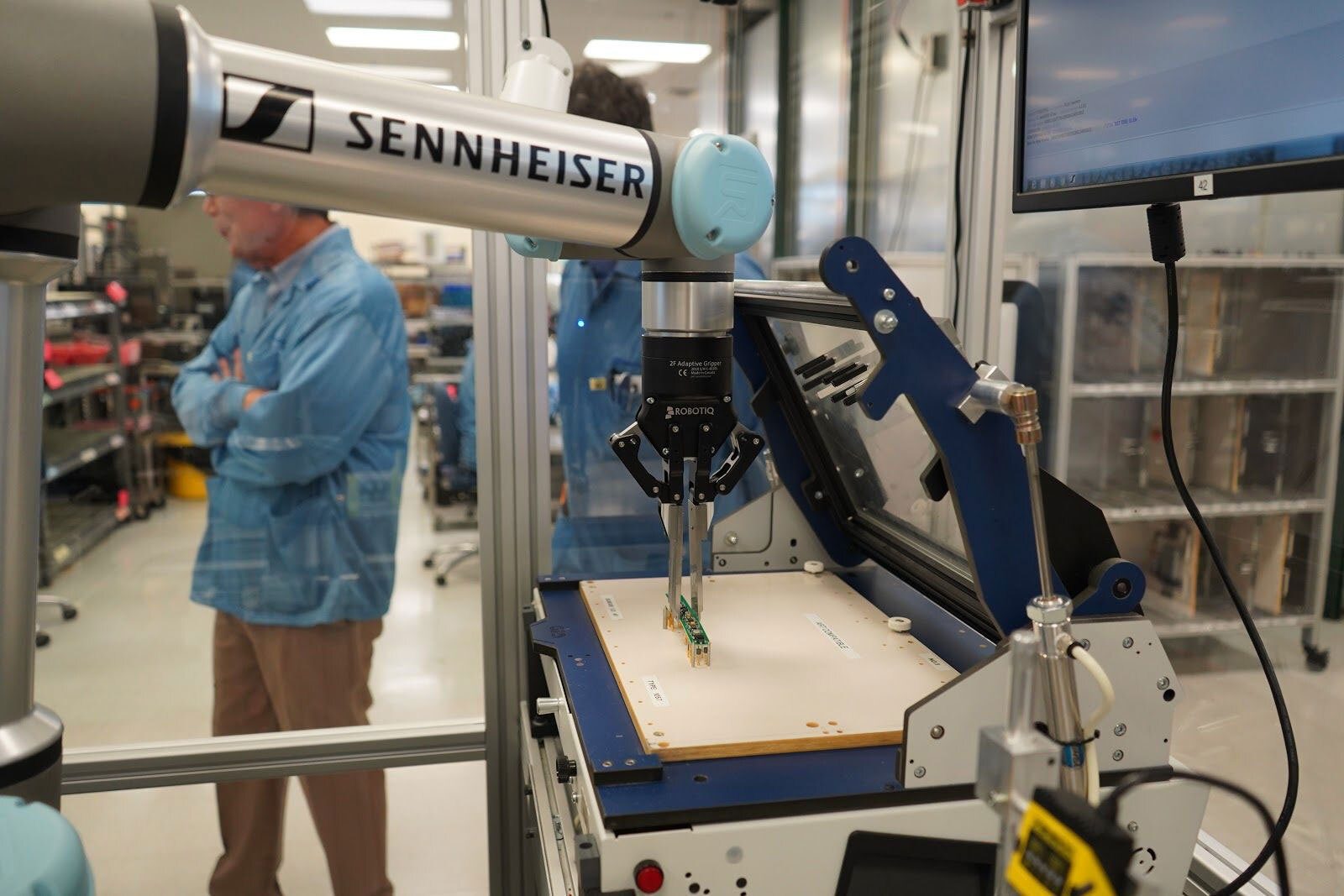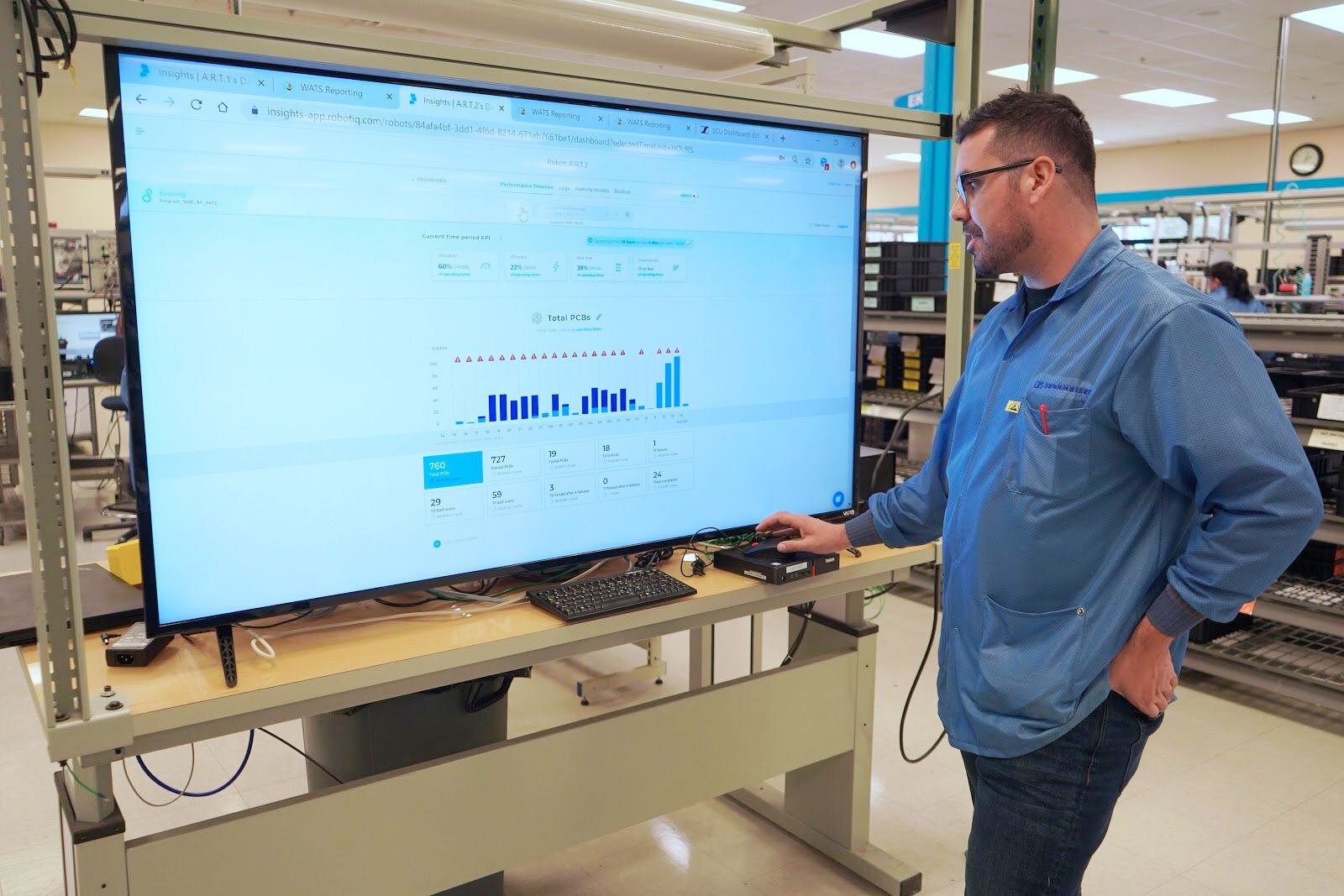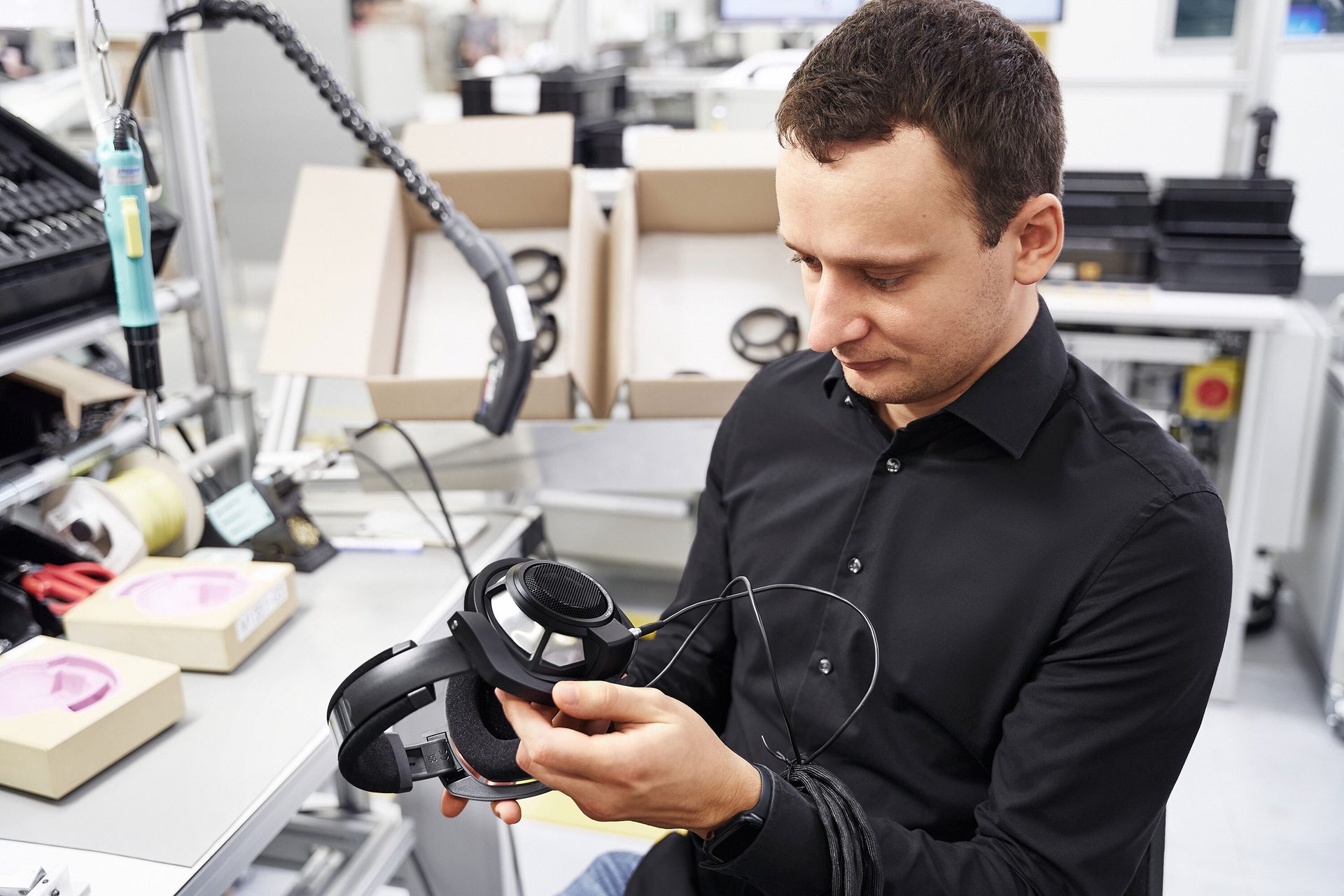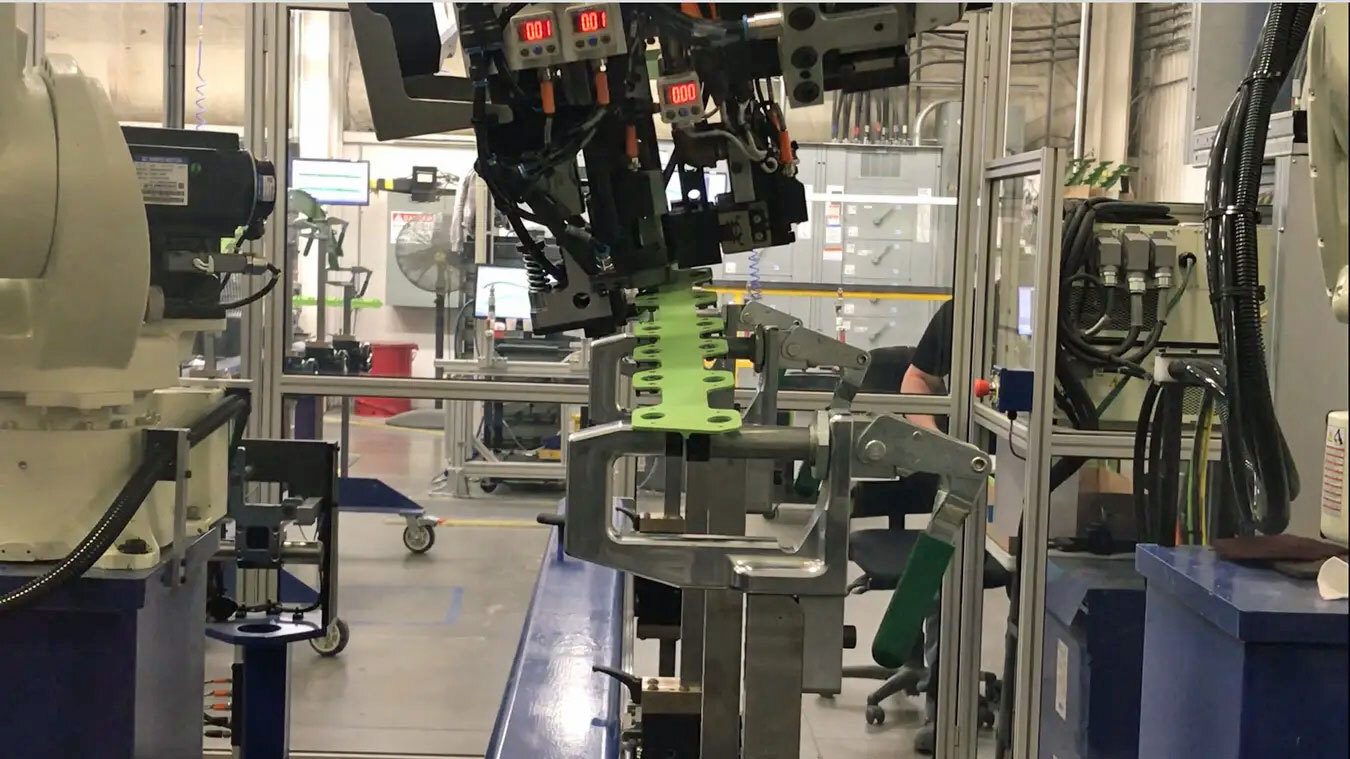Test and Inspection
Labor shortages are driving new demand for automation.
Options for Screwfeeding
This adaptive gripper can gently and precisely handle circuit boards in a variety of shapes and sizes. Photo courtesy Robotiq
A flexible, adaptive gripper accommodates high-mix, low-volume production.
Cobot Boosts
Output by 33 Percent
Linnea Bruce // Strategic Communications Specialist // Robotiq // Levis, Quebec, Canada
German audio equipment manufacturer Sennheiser Electronic GmbH & Co. was founded in 1945 shortly after the end of World War II by Fritz Sennheiser and seven fellow engineers from the University of Hannover.
The company’s first product was actually a voltmeter, but in 1946, the company began making microphones designed for broadcast reporting. By 1955, the company had 250 employees and was producing an array of audio products. Today, Sennheiser is one of the world’s leading manufacturers of headphones, microphones and wireless transmission technology. Its products are found on concert stages, television studios and film sets around the world.
The family-owned company operates assembly plants in Germany, Ireland, Romania and the U.S. and is active in more than 50 countries worldwide.
Built in the early 2000s, the company’s U.S. factory is located in Albuquerque, NM. The plant assembles some 30,000 printed circuit boards—which go into 1,500 new professional audio devices—every week. The key to such high throughput? Automation. Since the factory opened, many automated machines have been deployed to assemble millions of components into 115 different PCBs.

Sennheiser employees were so pleased with their automated colleague, they named it ART, for Automated Robotic Team member. Photo courtesy Robotiq
Until recently, however, the process of testing those PCBs was manual.
“At Sennheiser, we test everything 100 percent,” says manufacturing manager Steven Nery. “Typically, you would have an operator putting a PCB in the tester and closing it. When testing is done, the operator removes it and puts in a new one—and repeats that for eight hours.”
As PCB production increased, testing became a bottleneck. In mid-2016, test engineer Roger Case looked into automating the task with a robot. The key would be finding a gripper that could gently and precisely handle boards in a variety of shapes and sizes. Sennheiser found one in Robotiq’s 2F-85 adaptive gripper.
With two stroke lengths of 85 and 140 millimeters, these tools can grip a wide range of objects. Their patented mechanical design allows for both encompassing and pinch grips, providing precise and powerful handling that leads to optimal performance in various applications. The gripper can carry a maximum payload of 5 kilograms, and it can exert a gripping force of 20 to 235 newtons.
“Robotiq had a unique solution: a reliable gripper that can manage part changeovers quickly, which was important for our high-mix, high-volume production,” Case says. “Plus, its wide stroke fit the form factor of the PCBs we were looking at.”

Insights software is a cobot-specific tool to track the key performance indicators that engineers needed to optimize production. Photo courtesy Robotiq
In a matter of weeks, Case and Nery—with help from a team of experienced manufacturing professionals at Sennheiser—automated a repetitive testing process with a UR5 collaborative robot from Universal Robots.
“The robot picks the PCB up with its gripper, moves it to a scanner to validate the part ID, and places the part in the tester,” says Case. “That sends the tester a message to start testing. Once it’s done, the testing system sends a pass or fail message to the robot, which picks the part again and puts it in the appropriate pass or fail bin.”
Cobot KPIs
When the first robot arrived at Sennheiser USA, it received a warm welcome. Every department, including HR, was closely involved from the start. The company even held a contest to name the robot, and decided on ART, for Automated Robotic Team member.
“Since we always need to evaluate how new employees are performing,” Case recalls, “I told our managers we should do the same for ART.”
Following that conversation, Nery began looking for cobot-specific monitoring tool to track the key performance indicators engineers needed to optimize production. They found just such a tool in Robotiq’s Insights software. Nery connected the robot to the factory’s internet and paired it with the Robotiq Insights web application.
“It has become a shop floor control tool. We have three different groups of people who use it for various reasons,” says Nery. “I use it to communicate information to non-engineering people, because I can just point to the dashboard and explain what’s going on. Roger [Case] likes to get daily reports of his tests and receive all alerts if the robot stops. So if there’s a problem, we’re able to attack it very quickly.”
Management also became interested in Insights. Case used the production data from ART to justify the purchase of ART 2, a UR5e cobot.
“With ART 1, we saw an increase of around 33 percent in the number of PCBs tested over a year, and the quality was higher because the handling was more consistent,” he says.
Now, with ART 2 installed next to ART 1, the factory is aiming to double PCB testing capacities. “This is just the beginning,” predicts Case.

Sennheiser is one of the world’s leading manufacturers of headphones, microphones and wireless transmission technology. Photo courtesy Sennheiser Electronic GmbH & Co.
Robotic Colleagues
Anytime the robot has emptied all its trays, PCB testing operator Marcella Segovia receives a text message from Insights. Then she knows it’s time to load new trays. They’re often filled with another type of PCB, so she changes the robot program to let the gripper know which part to pick.
“I was a little scared of the robots at first, but I really wanted to learn how to run them,” she says. “They’re fast, but I can keep up—and it’s great how much we’ve increased our numbers. I sometimes joke that they’re my babies, but they’re more easygoing than real children, because as long as I feed them they never argue back!”
A grandmother of four, Segovia used to perform the repetitive manual PCB testing process. She now runs the robot’s testing operations, preparing trays for testing, prioritizing job orders, and programming the robot, without any prior expertise in this field. Segovia is enjoying her new role as a vital member of the team, working alongside robots at the center of the factory’s evolution.
For more information on robotic grippers and peripherals, click https://robotiq.com.







